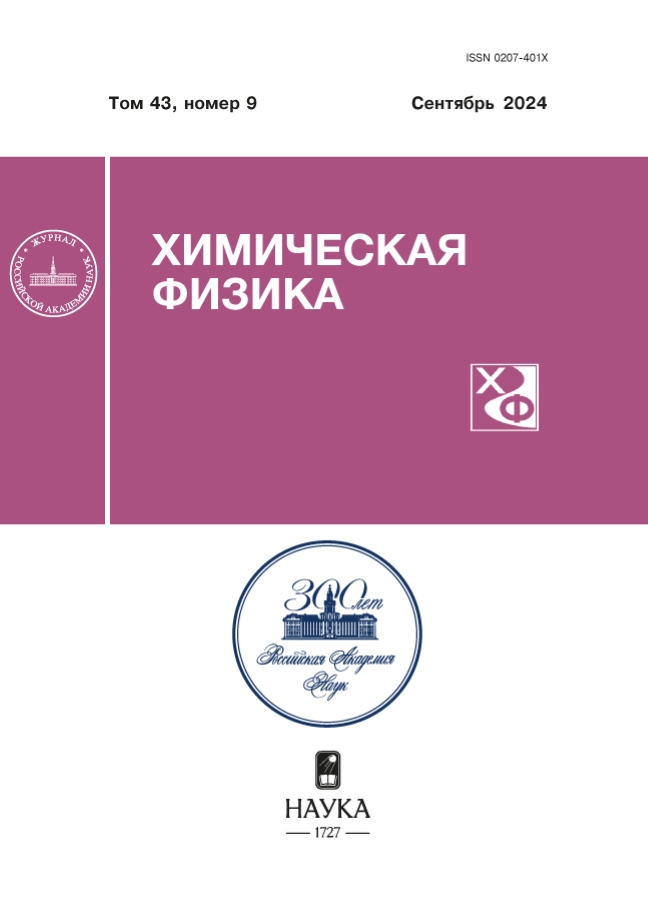Stabilization of silver iodide sols particles by acetate and N-scucinil of chitosan
- 作者: Bazunova M.V.1, Chernova V.V.1, Kulish E.I.1
-
隶属关系:
- Federal State Budgetary Educational Institution of Higher Education «Ufa University of Science and Technology»
- 期: 卷 43, 编号 9 (2024)
- 页面: 75-83
- 栏目: Chemical physics of polymeric materials
- URL: https://kld-journal.fedlab.ru/0207-401X/article/view/680969
- DOI: https://doi.org/10.31857/S0207401X24090099
- ID: 680969
如何引用文章
详细
The article is devoted to the study of the regularities of stabilization of colloidal particles of silver iodide sols by polymeric stabilizers – chitosan acetate and sodium salt of chitosan N-succinyl. The relevance of the work is due to the fact that the creation of stable polymer-colloidal dispersions based on water-soluble derivatives of chitosan and inorganic colloidal particles with antiseptic properties is one of the ways to create hybrid gel-like and film materials for biomedical purposes. It was proved that in the presence of chitosan acetate polycation with a concentration of 0.1% mas. adsorption of similarly charged macroions on the particles of the dispersed phase leads to an increase in the stability of the AgI sol with positively charged colloidal particles using measurements of electrokinetic potential. The AgI sol with positively charged particles is recharged and the electrokinetic potential of the AgI sol with negatively charged particles increases with a simultaneous increase in the aggregative stability of the sols in the presence of the polyanion – N-succinyl chitosan. Using potentiometric titration have shown that the increase in the aggregative stability of silver iodide sols at higher concentrations of chitosan acetate and chitosan N-succinyl is more associated not with the adsorption of macromolecules on the sol surface, but with an increase in the viscosity of solution with increasing polymer concentration (structural-mechanical barrier according to Rehbinder). Data of optical spectroscopy and viscometry indicate that the mixing of silver iodide sols with solutions of polymers of chitosan acetate and N-succinyl chitosan is accompanied by the formation of stable polymer-colloidal dispersions, the components of which interact with each other, and do not represent mechanical mixtures of a polymer solution and a colloidal solution.
全文:
作者简介
M. Bazunova
Federal State Budgetary Educational Institution of Higher Education «Ufa University of Science and Technology»
编辑信件的主要联系方式.
Email: mbazunova@mail.ru
俄罗斯联邦, Ufa
V. Chernova
Federal State Budgetary Educational Institution of Higher Education «Ufa University of Science and Technology»
Email: mbazunova@mail.ru
俄罗斯联邦, Ufa
E. Kulish
Federal State Budgetary Educational Institution of Higher Education «Ufa University of Science and Technology»
Email: mbazunova@mail.ru
俄罗斯联邦, Ufa
参考
- A.B. Shcherbakov, G.I. Korchak, E. V. Surmasheva, et al., Farmacevticheskij zhurnal 5, 45 (2006). (in Russian). https://www.researchgate.net/publication/321754788_Preparaty_serebra_vcera_segodna_i_zavtra
- Rasulov B.A., Jun L.W., Davranov K.D. Microbiol. 86 (2), 197 (2017). https://doi.org/10.1134/S0026261717020175
- F.P. Sidel’kovskaya. Himiya N-vinilpirrolidona i ego polimerov. M.: Nauka, 1970. (in Russian).
- E.M. Blagitko, P.P. Rodionov, N.V. Bugajchenko, et al. Ointment “Hidropent” For Treatment Of Infected Wound, RU 2233652 C1 (2004). (in Russian).
- M.A. O’Neill, G.J. Vine, A.E. Beezer, et al., Int. J. Pharm. 263 (1), 61 (2003). https://doi.org/10.1016/s0378-5173(03)00361-2
- Furr J.R., Russell, A.D., Turner T.D., Andrews A., J. Hospital Infection. 27 (3), 201 (1994). https://doi.org/10.1016/0195-6701(94)90128-7
- A.B. Lansdown, K. Jensen, M.Q. Jensen, J. Wound Care. 12 (6), 205 (2003). https://doi.org/10.12968/jowc.2003.12.6.26507
- S. Thomas, P. McCubbin, J. Wound Care. 12 (6), 101 (2003). https://doi.org/10.12968/jowc.2003.12.3.26477
- Wright J.B., Lam K., Olson M.E., Burrell R.E., Wounds-A Compendium Of Clinical Research And Practice. 15 (5), 133 (2003). https://www.researchgate.net/publication/285942780_Is_antimicrobial_efficacy_sufficient_A_question_concerning_the_benefits_of_new_dressings
- G. Müller, Y. Winkler, A. Kramer, J. Hospital Infection. 53 (3), 211 (2003). https://doi.org/10.1053/jhin.2002.1369
- A.I. Slivkin, V.L. Lapenko, A.P. Arzamascev, A.A. Bolgov, Vest. Voronezh. gos. univer. Ser.: Him. Biol. Farmaciya. 2, 73 (2005). (in Russian). http://www.vestnik.vsu.ru/pdf/chembio/2006/01/ 2006-01-44.pdf
- Shurshina A.S., Galina A.R., Kulish E.I. Russ. J. Phys. Chem. B 16 (2), 353 (2022). https://doi.org/10.1134/S1990793122020221
- Shurshina A.S., Galina A.R., Lazdin R.Y., Chernova V.V., Kulish E.I. Russ. J. Phys. Chem. B 15 (4). 724. (2021). https://doi.org/10.1134/S1990793121040096
- Bazunova M.V., Mustakimov R.A., Kulish E.I. Russ. J. Phys. Chem. B 15 (5). 888. (2021) https://doi.org/10.1134/S199079312105002X
- Bazunova M.V., Mustakimov R.A., Kulish E.I. Russ. J. Phys. Chem. B 17 (1), 182 (2023). https://doi.org/10.1134/S1990793123010025
- M.V. Bazunova, R.Yu. Lazdin, M.R. Elinson, et al., Chimica Techno Acta. 9 (1), 20229108 (2022). https://doi.org/10.15826/chimtech.2022.9.1.08
- Lazdin R.Y., Chernova V.V., Bazunova M.V., et al., Russ. J. Appl. Chem. 93 (1), 65 (2020). https://doi.org/10.1134/S1070427220010073
- M.V. Bazunova, R.YU. Lazdin, M.A. Elinson, et al., Butler. soobshch. 60 (10), 42 (2019). (in Russian). ROI: jbc-01/19-60-10-42
- Laboratornye raboty i zadachi po kolloidnoj himii / Pod red. YU. G. Frolova and A.S. Grodskogo. M.: Himiya,1986. (in Russian).
- V.I. Klenin, Termodinamika sistem s gibkocepnymi polimerami. Saratov: Izd-vo Saratovskogo un-ta (1995). (in Russian).
- V.I. Klenin, S.YU. SHCHegolev, V.I. Lavrushin, Harakteristicheskie funkcii svetorasseyaniya dispersnyh sistem. Saratov: Izd-vo Saratovskogo un-ta, (1977). (in Russian).
- Varekhov A.G. Method for determining the electrokinetic potential of colloidal particles, RU 1658042 C1 (1991). (in Russian).
- G.K. Budnikov, V.N. Majstrenko, M.R. Veselov, Osnovy sovremennogo elektrohimicheskogo analiza. M.: Binom (2003). (in Russian).
- Baranov V.G., Amribakhshov D.Kh., Agranova S.A., Frenkel S. Ya., High-molecular compounds. Ser. B 30 (5), 384 (1988) (in Russian). http://polymsci.ru/static/Archive/1988/VMS_1988_T30ks_5/VMS_1988_T30ks_5_384-386.pdf
- M. V. Bazunova, D. R. Valiev, Y. S. Zamula, et al., Russ. J. Phys. Chem. B 11 (3), 513 (2017). https://doi.org/10.1134/S1990793117030174
- I.M. Solomenceva, A.A. Baran, O.D. Kurilenko, Fiziko-himicheskaya mekhanika i liofil’nost’ dispersnyh sistem. Kiev: Naukova Dumka (1975). (in Russian).
补充文件














